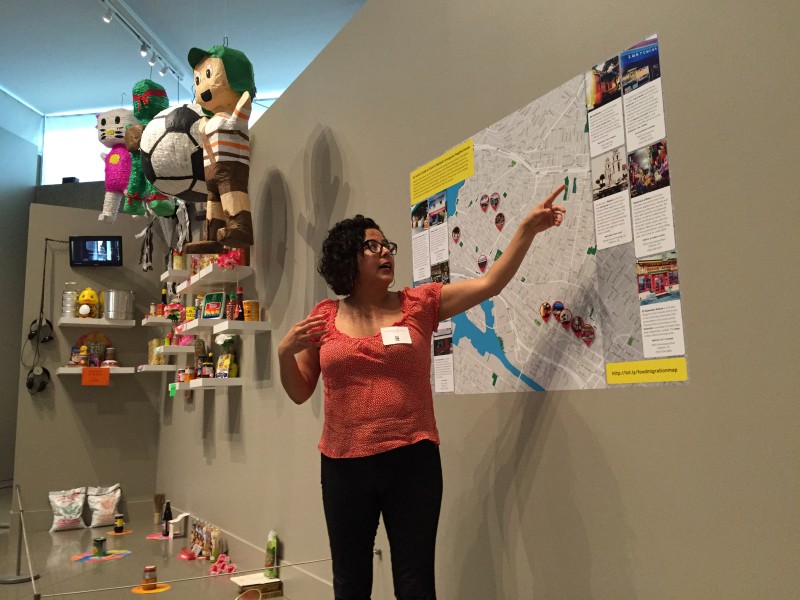So Johnson, a long time Oakland resident and professor of photography at the California College of the Arts, turned to his colleagues and former students to fill the gallery.
“It’s not so hard,” he says, “if you’re basing the project on the lived experiences of real people.”
For instance Adia Millet scattered a murder of crows around the gallery as a metaphor for gentrification.
Crows thrive in a disrupted and changing environment -- a situation that’s tough, Johnson says, on the artists themselves.
“My students really struggle to find a way to like continue living here," Johnson says. "On the other hand it’s such a vibrant place, there’s so much going on.”
Gentrification is also on the mind of artist Favianna Rodriguez, whose work often focuses on social justice and immigration.
“There’s a lot of pain,” Rodriguez says. “There’s a lot of anger because of the rising housing costs, because of how people are being displaced.”
Still Rodriguez' "Who is Oakland?" piece focuses not on the city’s problems but on the survival of what’s here.
“For example, people think that the San Antonio is an Asian community,” she says. “Well there’s Cambodians, there’s Filipinos, there’s Chinese. There’s now Jamaicans. There's newcomers every single year, and that’s a beautiful complexity.”
Rodriguez shopped corner groceries in San Antonio and its neighbor, the mostly Latino Fruitvale district, to assemble her own tiny international grocery, featuring items like a can of Café Bustelo, Hup Seng cream crackers and bags of rice.
“And the chicken bouillon there,” she says, pointing to the packets, “you see it in three different languages. It was not uncommon to go into the supermarket and see the same exact item marketed to three different constituents.”
Rodriguez also visited a piñata maker to see how cultures blend.
“Here we have a Japanese icon,” said Rodriguez, “Hello Kitty, created in a piñata and sold in East Oakland. Culture does not recognize borders.”
Immigration is also a theme for Susan Felter.
She’s created three huge photo collages depicting Oakland’s natural environment, an aspect of the city she says "that we often maybe don’t think about too much. But we actually share this environment with a lot of creatures."
Felter’s depiction of Lake Merritt is populated by California gulls, pelicans, mallards, a dragon kite and Canada geese. Another collage pairs raccoons and taco trucks in her neighborhood near Mills College.
Much of the work in the show is a counternarrative to the stereotypes so many people have about Oakland as a dangerous and gritty city.
That's true for Christopher Johnson's piece, “The Best Way to Find a Hero.”
Johnson cut up a map of the city and taped together what he calls “all the bad neighborhoods. All the places that are in the so-called kill zone.”
And then he threw darts at the map, visited the homes his darts chose for him, and videotaped interviews with the “heroes” who lived there.
“I live in the Eastmont hills, above East Oakland," Johnson says. "So my wife and I hear gunshots just about every day and sirens. But when you drive through, you see properties that are beautifully maintained and when you knock on the doors, you see people who are raising their families, and proud to have lived and survived.”
With the touch of a button on a kiosk, you can watch Johnson’s interview with Michael Nelson and his wife Chestine.
“This block here is cool," Michael Nelson says of his East Oakland neighborood. "I cut the neighbors grass, we go out and pick up trash. We all know one another and look out for each other and stuff.”
“That’s what we got to get back to,” Chestine Nelson interrupts. Michael picks up without a pause, “And you got to go from this block to that block to that block. That’s how we get our neighborhoods back.”
Don’t visit "Who is Oakland?" if you’re expecting a definitive answer to that question. But here’s Favianna Rodriguez's take.
“Oakland is the past and the present," she says. "It’s the collision of cultures. It’s what emerges when migrants come together to form a new reality, to form a new community."
"Who is Oakland?" continues through July 12.
KQED's Forum will do a remote broadcast next Wednesday, April 22, from the Oakland Museum of California and feature some of the artists in the "Who is Oakland?" show.
